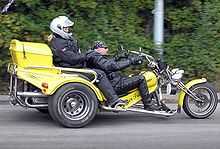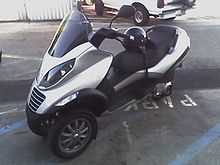Motorized tricycle

A motorized tricycle is a three-wheeled vehicle, based on the same technology as motorcycles or bicycles, and powered with a motor. Motorized trikes can be powered by motorcycle engines, smaller automatic transmission scooter motors, or electric motors.
Depending on the design of the vehicle, motorized trikes may be categorized as motorcycles, motor scooters, or simply the three-wheeled counterpart to a motorized or electric bicycle. The main difference between a motorcycle trike and a scooter trike is that motorcycles are sat on in a "saddle"-style seating (as with a horse), with the legs apart, and motorcycles have manual transmissions. Scooters have a "step-through" seating style, in which the driver sits on a more chair-like seat, with the legs together; as well, scooters have automatic transmissions. While laypersons often associate the engine size as a dividing line between motorcycles and scooters, since a typical scooter has a small 50 cc engine, engine size is not one of the dividing lines, because some scooters such as the Burgman have 638 cc engines.
Motorcycles with sidecars are not usually considered tricycles. It can be harder to categorize three-wheeled automobiles. While some early prototype automobiles were steam tricycles, 1930s and 1940s-era three-wheeled cars such as Morgan Motor Company cars are often classified as cars rather than motorcycles.
Motorcycle tricycles


A motorized tricycle's wheels may be arranged in either configuration: delta or tadpole. A delta trike has one wheel in front and two in back, and the tadpole trike has two wheels in front and one in back. Occasionally, rear wheel steering is used, although this increases the turning circle and can affect handling (the geometry is similar to a regular trike operating in reverse, but with a steering damper added). Thrust SSC used a rear-steer tadpole layout (technically, Thrust SSC was not a tricycle; it had four wheels, two at each end. The rear steering wheels (2) were mounted very close together).
Tadpoles are more stable under braking and more likely to slide instead of roll; front braking hard on a delta requires the vehicle to steer almost straight to avoid tipping. The balance of friction patches and rolling resistance also means that tadpoles tend to oversteer and deltas understeer.
Motor trikes are attractive for those with mobility or balance problems.
Under some local regulations, while riding a three-wheeled vehicle, it may be possible to carry multiple passengers with a motorcycle driving license, to ride a motorcycle-style vehicle with a car license, or to avoid motorcycle helmet use regulations.
These machines are generally custom-built and often finished to a very high standard. A common arrangement is to fit chopper-style ("ape hanger") front forks to a VW Beetle engine and transaxle, popular because it is largely self-contained on a single subframe. Similarly, the engine, transmission and rear wheel may be taken from a large motorcycle as a single unit, and used in the construction of a tadpole trike.
Mass-manufactured motor tricycles include the Piaggio MP3; the Piaggio Ape (Italian for Bee) delivery trike (delta); the Harley-Davidson Tri Glide Ultra Classic; the Bombardier Recreational Products Can-Am Spyder (tadpole); the T-Rex reverse trike; trikes used by municipal authorities in the USA; and, historically, vehicles such as the Scammell Scarab railway dray, a common sight around post-war British railway stations.
Motorized freight trikes
In Asian and Southeast Asian countries, motorized trikes are used as small freight trucks and commercial vehicles. Nicknamed "three-wheelers" or "tuk-tuks" in popular parlance, they are a motorized version of the traditional rickshaw or velotaxi. They have a small three-wheeled cart driven by a person, and is related to the cabin cycle.While they are mostly used as taxis for hire, they are also used for commercial and freight deliveries. They are particularly popular where traffic congestion is a problem in cities like Bangkok, Dhaka, Ahmedabad, Pune, Delhi,[1] Mumbai, Chennai, Hyderabad and Bengaluru,[2]
They usually have a sheet-metal body or open frame that rests on three wheels, a canvas roof with drop-down sides, a small cabin in the front of the vehicle for the driver, an air-cooled scooter version of a two-stroke engine, with handlebar controls instead of a steering wheel. The smaller motorized trikes are used as delivery vehicles for lighter loads. The larger trikes, with more powerful engines, have larger cargo bays, and they can carry freight within a city.
Motorized scooter trikes
Scooters are motor vehicles that can vary significantly in design and capability, but are generally derived from a traditional design combining a step-through frame with front fairings and floor boards, inner fairing storage, small wheels (10" to 16" in diameter), and a rear swingarm-mounted engine suitable for light duty. The classic scooter design features a step-through frame and a flat floorboard for the rider's feet. Most newer scooters use a continuously variable transmission (CVT). While most scooters have two wheels, some scooters are three-wheeled scooter trikes.
Most scooter trikes have two rear wheels which are the drive wheels and a front wheel which is used for steering. Some first decade of the 21st century-era scooter trikes such as the Piaggio MP3 are reverse trikes, with two wheels in front and one in the back. The MP3 leans like a 2-wheeled bike, with the front wheels moving independently in a scissors action.
Motorized stand-up trikes

Some types of motorized trikes may be stand-up types, and may be used in law enforcement, security, and patrolling.[3][4]
Country specific
Philippines
In the Philippines, motorized tricycles are used as a public utility vehicle and for personal transportation.
India
Since 2012, the introduction of e-rickshaws in India, they have been very popular, they are electric tricycles, replacing other commercial transports and has been very popular since then. These vehicles are powered through an electric motor.[5] For vehicles other than Electric rickshaw, various locally made configurations are used around India. They fall under the category of Jugaad and serve as both passenger and commercial vehicles. The motorized versions are popular because of their low cost as they are put together from salvaged motorcycles and often do not require the operator to have a driving license.
Gallery
-

Tricycle truck in China
-
Motorized tricycle in Dumaguete City, Philippines
See also
References
| Wikimedia Commons has media related to Three-wheeled motorcycles. |
- ↑ "Taxi, autorickshaw strike hits life in Delhi". The Tribune, India. 2002-02-04. Retrieved 2009-02-23.
- ↑ "Autorickshaw strike called off ; talks today". The Hindu. 2007-11-05. Retrieved 2009-02-24.
- ↑ Kaminer, Ariel (22 October 2010). "To Serve and Protect, Perched on 3 Wheels". New York Times. Retrieved 15 November 2012.
- ↑ Krieger, Kimberly (8 February 2010). "Regulating on three wheels". Daily Sundial. Retrieved 15 November 2012.
- ↑ http://www.gemev.com/erickshaw.html
| ||||||||||||||||||||||||||||||||||||||||||||||||

